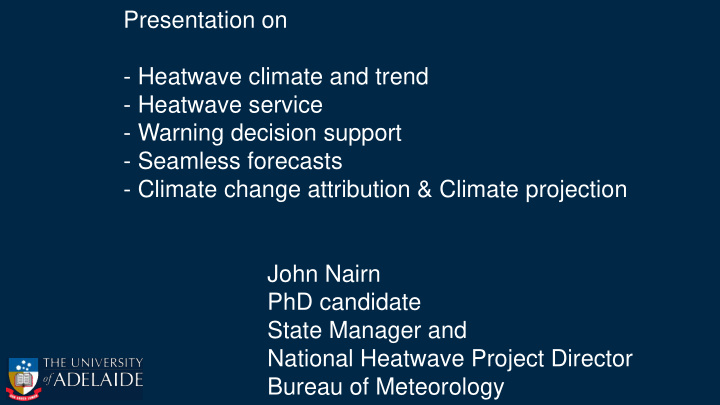



Presentation on - Heatwave climate and trend - Heatwave service - Warning decision support - Seamless forecasts - Climate change attribution & Climate projection John Nairn PhD candidate State Manager and National Heatwave Project Director Bureau of Meteorology
Heatwave service • Maps showing colour-coded heatwave severity for the previous two three-day periods, and the 11°S 11°S next five three-day periods • Heatwave evaluation is based on: 25°S – 25°S Intensity as a function of long and short term daily temperature anomaly – Severity categories as a function of the 85 th percentile of heatwave intensity climate distribution • Gridded data via FTP / WMS • Public display available on BOM website Heatwave Service www.bom.gov.au/australia/heatwave/
Warning Decision Support – national framework
The role of seasonal, multi-week and daily forecasts Probability of severe heatwave
Can we attribute the health impacts of heatwaves to climate change? Workshop held at UNSW Sydney October 2018, bringing together experts in heatwaves, detection and attribution of climate extremes, and human health Planning a commentary/perspective discussing: • various ways heatwave impacts might be attributed to climate change • challenges in bringing disparate research communities together • Future directions of appropriate methods to attribute any impacts of extremes to climate Mitchell et al. 2016 attempted this for the 2003 European change heatwave A special issue on attributing the health impacts Event was attributed to climate change over Paris and of heatwaves to climate is planned for 2020/2021 London, and was fitted to the respective excess mortalities Contact Sarah Perkins-Kirkpatrick Useful and cutting edge, but idea needs to be examined (sarah.Kirkpatrick@unsw.edu.au) for more further information
What is GLORIOUS? GLObal useRs In the cOpernicUs climate change Service (GLORIOUS) → Berit Arheimer, SMHI C3S_422_Lot1_SMHI The aim is to ensure user uptake of relevant (and high-impact) climate information from the C3S Climate Data Store, addressing sectors such as health, agriculture and food security, transport, tourism, biodiversity, health and natural hazards
Summer (DJF) heat wave SEVERITY – future change Scenario = RCP85 (high); Compare HIST (1976-2005) and RCP85 (2071-2100) RCP85 Change in mean OBSERVATION mean HIST mean Key messages: ➢ Spatial distribution of severity in OBS ➢ CMIP5 models do a fairly good job (HIST mean) ➢ Future Change in HIST P90 RCP85 Change in P90 severity: ➢ Coastal impacts ➢ Seasonal extension (not shown here) ➢ Model range shows much higher values are possible in future ➢ Urban: large increase in heat wave days either 0-1 = LOW heat wave 1-3 = SEVERE heat waves side of summer season >3 = EXTREME heat wave
GLORIOUS products • http://climateservice-global.eu/climate-impacts/ • http://climateservice-global.eu/showcases/
Recommend
More recommend